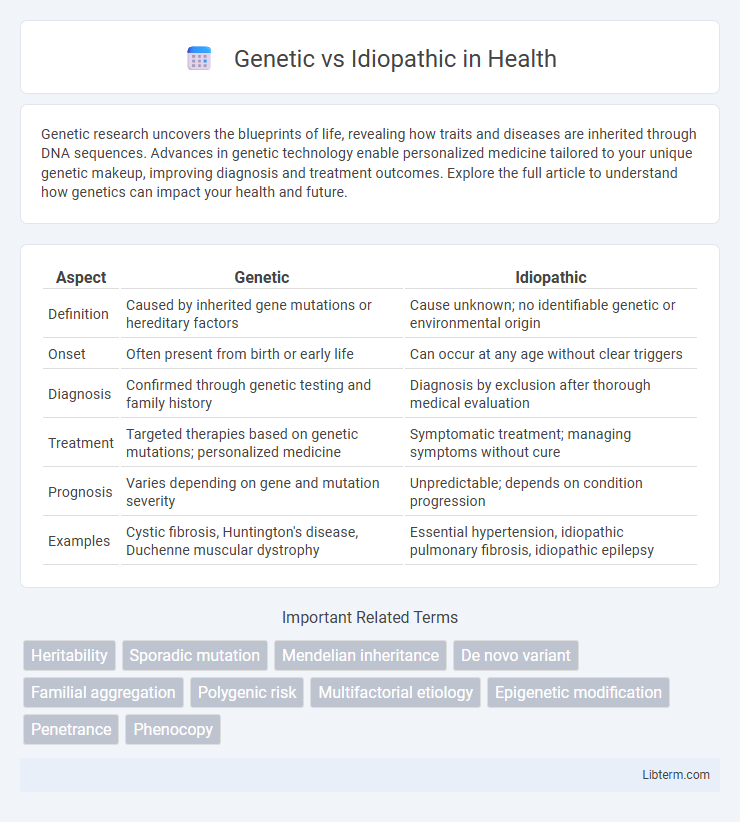Genetic research uncovers the blueprints of life, revealing how traits and diseases are inherited through DNA sequences. Advances in genetic technology enable personalized medicine tailored to your unique genetic makeup, improving diagnosis and treatment outcomes. Explore the full article to understand how genetics can impact your health and future.
Table of Comparison
| Aspect | Genetic | Idiopathic |
|---|---|---|
| Definition | Caused by inherited gene mutations or hereditary factors | Cause unknown; no identifiable genetic or environmental origin |
| Onset | Often present from birth or early life | Can occur at any age without clear triggers |
| Diagnosis | Confirmed through genetic testing and family history | Diagnosis by exclusion after thorough medical evaluation |
| Treatment | Targeted therapies based on genetic mutations; personalized medicine | Symptomatic treatment; managing symptoms without cure |
| Prognosis | Varies depending on gene and mutation severity | Unpredictable; depends on condition progression |
| Examples | Cystic fibrosis, Huntington's disease, Duchenne muscular dystrophy | Essential hypertension, idiopathic pulmonary fibrosis, idiopathic epilepsy |
Introduction to Genetic vs Idiopathic Conditions
Genetic conditions result from mutations or alterations in an individual's DNA, often inherited from parents or occurring spontaneously, leading to specific hereditary disorders. Idiopathic conditions, by contrast, lack a clearly identifiable cause despite thorough medical investigation, making diagnosis and targeted treatment challenging. Understanding the distinction between genetic and idiopathic conditions is crucial for accurate medical assessment, prognosis, and the development of personalized therapeutic strategies.
Defining Genetic Disorders
Genetic disorders arise from abnormalities in an individual's DNA, including mutations, deletions, or duplications of genes that cause inherited or spontaneous diseases. Unlike idiopathic conditions, which have unknown or unclear causes, genetic disorders can be traced to specific hereditary factors or chromosomal anomalies. Examples of genetic disorders include cystic fibrosis, sickle cell anemia, and Huntington's disease, all linked to identifiable gene defects.
Understanding Idiopathic Diseases
Idiopathic diseases are conditions with unknown causes, differentiating them from genetic diseases, which result from identifiable genetic mutations or inherited traits. Understanding idiopathic diseases involves extensive research into environmental factors, immune responses, and potential unknown genetic links that may contribute to their development. Advancements in diagnostic technologies and molecular biology are crucial for uncovering the underlying mechanisms of idiopathic conditions to improve treatment strategies.
Key Differences: Genetic vs Idiopathic
Genetic conditions arise from inherited mutations or alterations in DNA, which are often identifiable through family history or genetic testing. Idiopathic disorders lack a known cause, making diagnosis reliant on excluding other potential factors. Understanding whether a condition is genetic or idiopathic is crucial for prognosis, treatment strategies, and genetic counseling.
Causes and Risk Factors
Genetic causes of diseases are linked to inherited mutations or variations in DNA passed from parents to offspring, often associated with specific gene abnormalities such as BRCA1 in breast cancer. Idiopathic conditions, by contrast, have unknown or unclear causes despite extensive medical evaluation, making risk factors difficult to pinpoint. Environmental factors, lifestyle, and spontaneous genetic mutations may contribute to idiopathic disease development, but their precise role remains uncertain compared to clearly identified genetic causes.
Diagnostic Approaches
Genetic diagnostic approaches rely on DNA sequencing techniques, such as whole exome sequencing and targeted gene panels, to identify hereditary mutations linked to specific diseases. Idiopathic conditions, lacking identifiable genetic markers, often require comprehensive clinical evaluation combined with advanced imaging, laboratory tests, and exclusion of known causes to establish diagnosis. Integration of genetic testing with phenotypic assessments enhances accuracy in distinguishing genetic disorders from idiopathic presentations.
Examples of Genetic Disorders
Genetic disorders result from abnormalities in an individual's DNA, such as cystic fibrosis, sickle cell anemia, and Huntington's disease, which are caused by mutations inherited from parents. Idiopathic conditions, in contrast, have unknown or unclear causes with no identifiable genetic basis. Understanding specific genetic mutations helps in diagnosing hereditary diseases and developing targeted treatments.
Examples of Idiopathic Diseases
Idiopathic diseases, such as idiopathic pulmonary fibrosis and idiopathic thrombocytopenic purpura, are conditions with unknown causes, distinguishing them from genetic diseases, which result from inherited mutations or gene abnormalities like cystic fibrosis and Huntington's disease. Idiopathic epilepsy and idiopathic pulmonary arterial hypertension further exemplify disorders where etiology remains unclear despite extensive medical evaluation. Understanding the idiopathic nature of these diseases is crucial for developing targeted diagnostic and therapeutic strategies.
Treatment and Management Strategies
Treatment and management strategies for genetic conditions often involve targeted therapies addressing specific gene mutations, such as enzyme replacement or gene therapy, whereas idiopathic disorders require symptom-focused approaches due to unknown causes. Genetic disorders benefit from personalized medicine and genetic counseling to guide long-term care and family planning. Idiopathic cases rely heavily on comprehensive diagnostic evaluations and multidisciplinary management to control symptoms and improve quality of life.
Future Directions in Research
Future directions in research on genetic versus idiopathic conditions emphasize the integration of advanced genomic sequencing techniques with large-scale biobank data to unravel previously unidentified genetic variants associated with idiopathic cases. Machine learning algorithms are increasingly employed to analyze multi-omics datasets, facilitating the discovery of novel biomarkers that can differentiate genetic predispositions from idiopathic origins. Precision medicine approaches aim to translate these findings into targeted therapies and personalized intervention strategies, potentially transforming diagnostic accuracy and treatment efficacy in complex disorders.
Genetic Infographic

 libterm.com
libterm.com